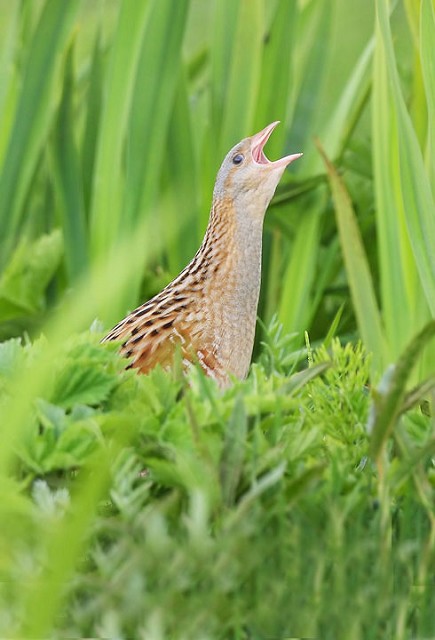Corncrakes face threats from funding cuts
The population of one of Scotland's rarest birds has increased; however, its future hangs in the balance as Scottish ministers consider massive cuts to agri-environment schemes that provide vital wildlife support payments to Scottish farmers and crofters. Recent counts of Corncrakes, an elusive farmland species, carried out by RSPB Scotland reveal that the population rose this year thanks to a 20-year partnership between conservationists, government and crofters. The count of singing Corncrakes, restricted in the UK almost exclusively to north and west Scotland, rose to 1213, an increase of 45 on the previous year. However, the wildlife conservation charity warns that the species' fortunes will dramatically reverse if the proposed cuts, outlined in the recent Scottish Spending Review, are approved.
The Spending Review singled out Scottish agri-environment schemes for major cuts, amounting to 22% until 2015; an £11m reduction over the next 3 years on top of a £10m reduction already applied in 2010–11. Corncrakes, once common across the farmed landscape in Scotland, suffered huge declines through the 20th century, reducing the population to just over 400 singing males in 1993. Research conducted by RSPB Scotland identified intensive agricultural production, especially early mowing of hay meadows and grazing of fields early in the season, as the cause of the drastic declines. These declines have been reversed in recent years following the introduction of a successful conservation scheme that maintains vital habitat by offering financial support to farmers and crofters to manage their land in a way that is sympathetic to Corncrakes. Since the start of the scheme, the Scottish Corncrake population has more than trebled, reaching a high this year. This is largely down to efforts of the crofters and farmers working closely with RSPB Scotland and Scottish Natural Heritage. Scottish Government agri-environment payments have allowed land-managers to care for hay meadows and field margins in a way that is sensitive to the species' needs while recognising the costs to the farmer of doing so.

Corncrake, Balranald RSPB, N.Uist, Outer Hebrides (Photo: Liz Street)
Farmers David and Sarah Hobhouse, of Balnahard on Colonsay, said: "Over the last 20 years or so, government agri-environment schemes have been the saving factor for agriculture on the island. The payments have not only had a huge impact on target species, like Corncrake, but they have contributed massively to maintaining diverse agricultural activities. Without this support the cattle would have long gone and the fencing and fields lost to be replaced with a smaller workforce and less use of ferries and other local services. Island farming can no longer be sustained on a purely commercial basis, as we are too far from both markets and suppliers, and our associated extra costs are considerable. Conservation payments are our lifeline."
Stuart Housden, Director of RSPB Scotland, said: "The steady increase in Corncrake populations is one of Scotland's great conservation successes and is directly attributable to the farmers and crofters who manage their land for the species and who rely on agri-environment schemes to do so. The proposed cuts will seriously compromise farmers' ability to help farmland wildlife and the environment in future. In setting the 2020 biodiversity targets, the Scottish Government committed itself to protecting Scotland's iconic wildlife and it must, as a priority, safeguard the one scheme that cares for Scotland's natural environment and invests in the benefits it provides. In addition to supporting Corncrake populations, research demonstrates that agri-environment-funded Corncrake management benefits a host of other biodiversity including bees, wild flowers and butterflies, which benefit from the late-cut meadows and margins the scheme supports."

